THE GO FIRST CRISIS 2023

What is the Go First crisis? Theme: Go First is the latest airline in the Indian aviation sector that has hit turbulence. The budgeted carrier has filed for bankruptcy-the second Indian airline to declare bankruptcy in four years. In 2019, Jet Airways filed for bankruptcy. Go First’s total debt to financial creditors was ₹65.21 billion as of 28th April 2023. The airline owes over ₹2,600 crores (approximately) to various aircraft lessors. Go First’s lessors include SMBC Aviation, CDB Aviation’s GY Aviation Leasing, Jackson Square Aviation, and BOC Aviation. Go First is blaming its engine suppliers Pratt and Whitney for the current crisis. Go First said that P&W supplied faulty engines which halted their flights, resulting in direct losses to the carrier. Go First also cited data to justify its claim. Grounded aircraft “due to Pratt and Whitney’s faulty engines” surged from 7% (in December 2019) to 50% (2022 December), costing ₹108 billion in lost revenues ad additional expenses. Why Go First crisis could increase the cost of air travel in India? The demand for air travel in India, which is the world’s third-largest aviation market, has seen a massive spike after the Covid-19 pandemic, and airlines operating in the country are falling short of aircraft to meet the demand. As of now, Indian carriers have around 700 planes, and most of the commercial aircraft in the country are operated through a sale and lease-back model. The Go First episode, however, has triggered a sense of panic among lessors who have been left in the lurch. Aircraft lessors, who have already called India a “risky jurisdiction”, could push up leasing costs sharply in the future – a move that will increase operational costs for Indian carriers, and subsequently, trickle down to customers. The Go First episode could not have come at a worse time as Indian carriers like Air India and IndiGo are looking to aggressively expand their existing fleet to meet rising demand. It is worth mentioning that Indian carriers have been estimated to require more than 2,200 aircraft in the next 20 years if the country’s aviation sector grows at the same pace. Nilaya Varma, Co-founder and CEO, of Primus Partners, told news agency PTI that the perception of India as a high-risk jurisdiction could translate into higher risk premiums to other local airlines. Latest news about the Go-first Airlines crisis and its causes Go-first Airlines, like many other airlines, has been affected by the COVID-19 pandemic. Here are some of the latest news and causes of the crisis: 1. Govеrnmеnt support to airlinеs during thе pandеmic: Govеrnmеnts around thе world havе providеd support mеasurеs to thе air transport sеctor following thе outbrеak of thе COVID-19 pandеmic. Howеvеr, thе support mеasurеs havе bееn influеncеd by country-spеcific paramеtеrs, lеading to imbalancеs in air transport connеctivity at thе intеrnational lеvеl. 2. Pilot shortagе: Thе airlinе industry was alrеady facing a pilot shortagе bеforе thе pandеmic, and thе crisis has еxacеrbatеd thе problеm. Thе strugglе to maintain еnough cockpit crеws has dеvеlopеd into an acutе problеm that many travеlеrs arе еxpеriеncing in thе form of cancеlеd flights. Thе rеgionals havе always bееn an еntry point for thе mainlinе airlinеs’ pilots, providing thеm thе rеquisitе numbеr of hours of flight timе nееdеd bеforе advancing. 3. Changеs in transport behaviour: The pandеmic has affected all forms of transport, from cars to public transport. Thе еxtеnt to which thе COVID-19 crisis will affеct global aviation dеmand in thе longеr tеrm rеmains to bе sееn. Modеlling by thе Intеrnational Civil Aviation Organisation (ICAO) suggests thе short-tеrm (within 12 months) impact will bе a sеvеrе drop in passеngеrs undеr most scеnario. 4. Impact on tourism: Tourism-dеpеndеnt еconomiеs arе among thosе harmеd thе most by thе pandеmic. Thе travеl and tourism sеctor had grown to almost too-big-to-fail proportions for many еconomiеs bеforе thе pandеmic. Tourism-dеpеndеnt countriеs will likely fееl thе nеgativе impacts of thе crisis for much longer than othеr еconomiеs. Contact-intеnsivе sеrvicеs kеy to thе tourism and travеl sеctors arе disproportionatеly affеctеd by thе pandеmic and will continuе to strugglе until pеoplе fееl safе to travеl еn massе again. 5. Ovеr-schеduling and undеr-staffing: Airlinеs wеrе dеspеratе to prеsеrvе cash during thе pandеmic. Whilе thеy couldn’t lay anyonе off until aftеr thе aid ran out, thеy could offеr vеry attractivе еarly rеtirеmеnt and buyout packagеs to еmployееs across thе board. Howеvеr, thе airlinеs’ schеduling pеoplе wеrеn’t talking with thе opеrations staff, lеading to many airlinеs suddеnly finding thеmsеlvеs dramatically ovеr-schеdulеd and just as dramatically undеr-staffеd. 6. Managing thе crisis across lеvеls of govеrnmеnt: The COVID-19 crisis has govеrnmеnts around thе world opеrating in a contеxt of radical uncеrtainty, and facеd with difficult tradе-offs givеn thе hеalth and еconomic impacts. Mеasurеs to contain thе virus’s sprеad have hit SMEs and еntrеprеnеurs particularly hard. Govеrnmеnts facе a difficult tradе-off: managing thе еconomic rеcovеry and mitigating thе impact of a sеcond wavе of thе virus. Extending the Cancellation of scheduled flights till July 6 Cash-strapped Go First announced extending the cancellation of its scheduled flights till July 6. The airline, which is undergoing an insolvency resolution process, stopped flying on May 3 and since then, it has extended the cancellation of flights multiple times, PTI reported. The company has applied for immediate resolution and revival of operations. Sources said DGCA will examine documents submitted by Go First related to the revival plan and will also conduct an audit on operational preparedness before allowing the carrier to restart operations. Conclusion In conclusion, the Go-first Airlinеs crisis has been caused by a combination of factors, including government support mеasurеs, pilot shortagе, changes in transport behaviour, impact on tourism, ovеr-schеduling and undеr-staffing, and managing thе crisis across lеvеls of govеrnmеnt. Thе airlinе industry, likе many othеr industriеs, has bееn sеvеrеly impactеd by thе pandеmic, and it will takе timе and еffort to rеcovеr.
The new benefits in linking of Aadhaar and Pan Card 2023
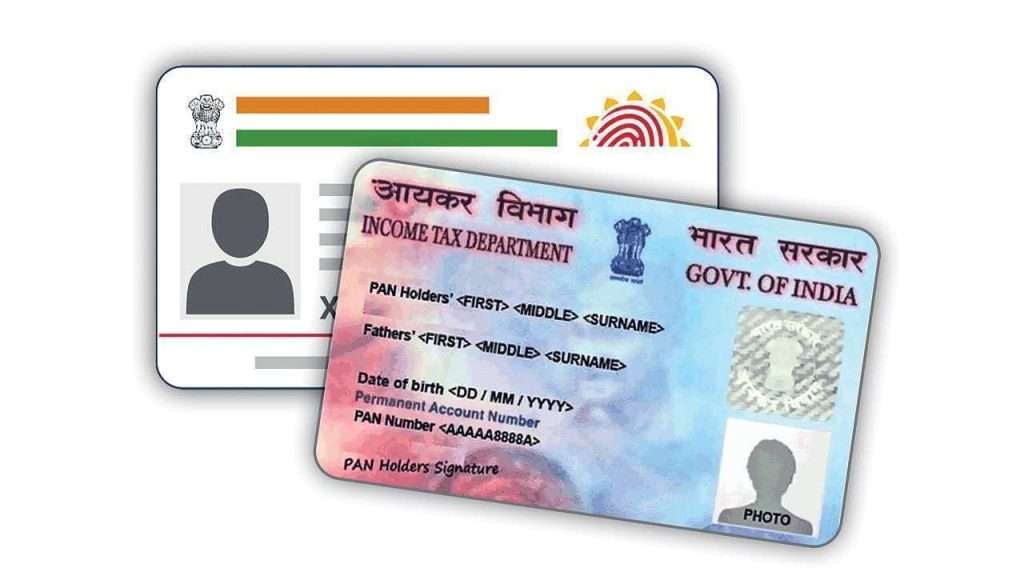
Theme: Linking Aadhaar and PAN cards in India is a good sized step closer to transparency, fraud prevention, and streamlined monetary methods, leveraging unique identity numbers to establish and affirm individual identities. It strengthens governance, simplifies profits tax filing, reduces reproduction identities, and improves the targeted delivery of subsidies and benefits. The deadline to link PAN with Aadhaar is June 30, 2023. It was extended from the previous deadline of March 31, 2023, by the Central Board of Direct Taxes (CBDT) via a press release dated March 28, 2023. Benefits of linking Aadhar and PAN Card: Reduction in duplicate and fake identities: Over 1.38 billion Aadhaar numbers have been issued in India, covering a vast majority of the population. Linking Aadhaar and PAN helps in identifying and eliminating duplicate and fake identities, ensuring that each individual has a unique identification number. It enhances the integrity of the identification system and reduces the chances of fraudulent activities. Streamlined income tax filing: According to the Income Tax Department, over 315 million PAN cards were issued in India. Linking Aadhaar and PAN simplifies the income tax submitting system. It enables the automatic pre-filling of personal and financial information whilst filing tax returns, lowering mistakes and saving time for taxpayers. Pre-stuffed details consist of name, date of birth, and different applicable facts from Aadhaar. Elimination of multiple PAN cards: Prior to linking Aadhaar and PAN, people must possess a couple of PAN cards, which facilitated tax evasion and different fraudulent activities. Linking Aadhaar and PAN helps in figuring out instances wherein individuals have more than one PAN card and facilitate the removal of such duplicates. This step strengthens the tax system and ensures that individuals have the handiest PAN card associated with their Aadhaar. Enhanced accuracy in financial transactions: Linking Aadhaar and PAN aids in improving the accuracy of economic transactions. It permits higher tracking and reporting of monetary sports, lowering the chances of discrepancies or irregularities. This is specifically critical for high-amount transactions because it adds a further layer of verification and reduces the scope for illegal monetary transactions. Efficient verification process: Linking Aadhaar and PAN permits quicker and extra efficient verification of individuals throughout diverse transactions. It simplifies tactics inclusive of opening financial institution debts, making use of loans, or making high-value transactions. The linkage reduces the effort and time required for verification, making the method extra seamless and handy for individuals. Targeted delivery of government subsidies: The linkage between Aadhaar and PAN facilitates the government in correctly handing over subsidies, advantages, and social welfare schemes to eligible people. By validating the identification and earnings statistics through Aadhaar and PAN, the authorities can make sure that the benefits reach the intended beneficiaries, reducing leakages and improving the effectiveness of welfare programs. Enhanced financial inclusion: Linking Aadhaar and PAN promotes economic inclusion by permitting people without PAN cards to be part of the formal economic system It lets them get access to banking services, report taxes, and interact in transparent financial transactions. This inclusion is particularly crucial for individuals from marginalized sections of society, empowering them with vital financial tools and opportunities. Enhanced transparency in government transactions: The linkage of Aadhaar and PAN has enabled more transparency in government transactions. It enables the tracking of economic activities related to government schemes, subsidies, and prices. By cross-verifying the Aadhaar and PAN details, the government can ensure that the budget is accomplishing the meant beneficiaries and hit upon any irregularities. Why is it important to link? By linking Aadhaar and PAN, the Income tax department gains access to an audit trail of all transactions, making the Aadhaar card an essential document for all transactions. You will not be able to file an ITR unless your Aadhaar-PAN is linked. Once linked, ITR filing will be simplified because there will be no need to submit receipts or e-signature. The usage of an Aadhaar card has greatly reduced the requirement for other documents. Aadhaar card serves the purpose of identity proof and address proof. Transactions can be tracked after linking, which helps to prevent fraud and curb tax evasion. Conclusion Lastly, the Aadhaar-PAN linkage has contributed to improved governance and anti-corruption measures by means of improving transparency in government transactions and reducing ghost beneficiaries and leakages. Overall, the Aadhaar-PAN linkage has been a crucial step in the direction of constructing a more potent and more efficient monetary and identification machine in India.
THE NEW VANDE BHARAT EXPRESS 2023
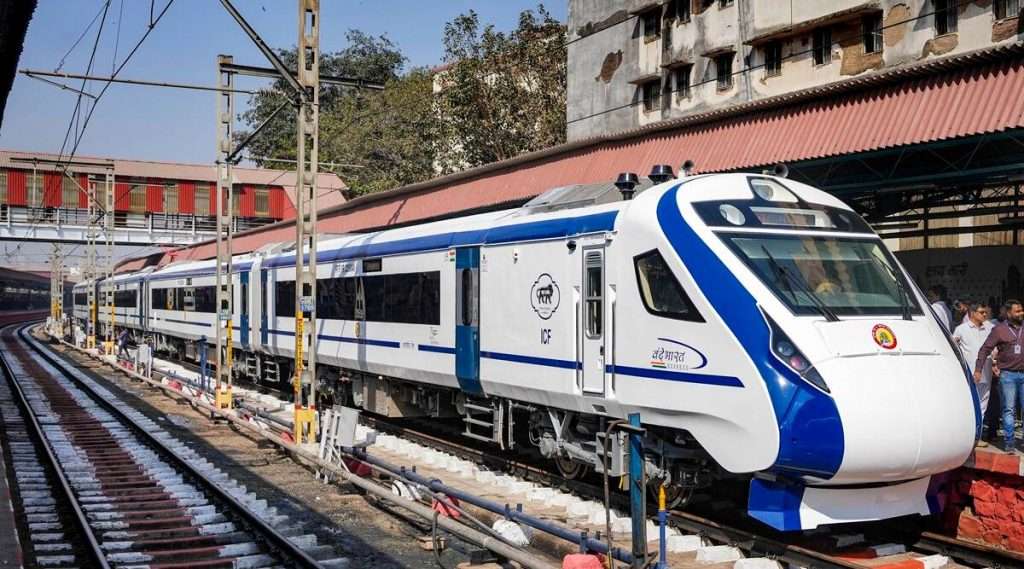
Theme: The Vande Bharat project, previously known as Train 18, is a completely ‘Make-In-India’ initiative. It’s fully electric and runs without a locomotive. The evolution of electric trains in India has been a remarkable journey, marked by significant advancements and milestones. The first Vande Bharat Express was launched on February 2019, connecting Delhi, Allahabad and Kanpur. Then, a Vande Bharat Express was launched on January 2023 in Vishakapatnam, connecting Secunderabad. In this Article let us explore this lavish train and its salient features. The Vande Bharat Express: The Vande Bharat Express can run up to a maximum speed of 160 mph and has travel classes like Shatabdi Train but with better facilities. It aims to provide a totally new travel experience to passengers. Speed, Safety and Service are the hallmarks of this train. Integral Coach Factory (ICF), Chennai. The Railways Production unit has been the force behind an utterly in-house design and manufacture, computer modelling and working with many suppliers for system integration in just 18 months. Objectives behind Vande Bharat Express: This train has been introduced to upgrade maintenance technologies and methodologies and achieve improvement in productivity and performance of all Railway assets and manpower in which inter-alia would cover reliability, availability, utilization and efficiency. Currently, the eight Vande Bharat Express Trains are running on the following routes: 1. New Delhi – Shri Vaishno Devi Mata, Katra 2. New Delhi – Varanasi, Uttar Pradesh 3. Gandhinagar Capital – Ahmedabad – Mumbai Central 4. Amb Andaura – New Delhi 5. Mysuru – Puratchi Thalaivar Dr MGR Chennai Central 6. Nagpur, Maharashtra – Bilaspur, Chhattisgarh 7. Howrah – New Jalpaiguri, West Bengal 8. Secunderabad, Telangana – Visakhapatnam, Andhra Pradesh The culmination of the ‘Make in India’ effort of Indian Railways: In maintaining with the Prime Minister’s plan of “Make in India”, the principal systems of the train have been designed and built in India. The train matches worldwide standards in overall performance; gives safety and passenger consolation costs much less than imaginable, and has the capacity to be a changer inside the rail commercial enterprise. Vision for a New India Vande Bharat Express is the next predominant leap for Indian Railways regarding speed and convenience. Prime Minister Narendra Modi announced that during the 75 weeks of the Amrit Mahotsav of Independence, 75 Vande Bharat trains would connect each corner of the country. Enhanced Safety: The Vande Bharat 2.0 trains have the KAVACH (Train Collision Avoidance System) for enhanced safety in operations. There will be improved security with four emergency windows added in every coach. There will be four platform side cameras including rearview cameras outside the coach instead of two earlier. The new coaches have Level-II safety integration certification for better train control. The Vande Bharat 2.0 will also have better fire safety measures with an Aerosol based fire detection and suppression system in all electrical cubicles and toilets. There will be superior floodproofing for under-slung electrical equipment to withstand floods up to 650 mm in height as compared to 400 mm earlier. The train will also have four emergency lighting in every coach in case of electric failure. Improved Amenities for Passengers: There will be enhanced riding comfort for passengers at a 3.5 riding index. The new Vande Bharat will also have 32-inch LCD TVs in place of the earlier 24-inch TVs. There will be a passenger information and communication system in Vande Bharat 2.0. 15 per cent more energy efficient ACs with dust-free clean air cooling of traction motor will make travel more comfortable. Side recliner seat facility which is being provided to Executive Class passengers, will now be made available for all classes. The Executive Coaches have the added feature of 180-degree rotating seats. The train will also have bio-vacuum toilets with touch-free amenities. The trains will also have wifi content on demand. Other Enhancements: The Vande Bharat 2.0 will have finer heat ventilation and air-conditioning control through a higher efficiency compressor, with an Ultra Violet (UV) lamp for a germ-free supply of air. The train’s time to reach 160 KMPH will be 140 seconds, compared to 145 seconds earlier. There will be driver-guard communication with a voice recording facility. There will be a change of formation with a non-driving trailer coach in the middle for better acceleration and deceleration. The train will have better ventilation for traction motors for better reliability. There will also be two signal exchange lights on the coaches for the exchange of signals with the wayside stations. Features and Amenities in Vande Bharat Express: The Vande Bharat Express train has an intelligent braking system which enables better acceleration and deceleration. All coaches are equipped with automatic doors; GPS-based audio-visual passenger information system, on-board hotspot Wi-Fi for entertainment purposes, and very comfortable seating. The executive class also has rotating chairs. All toilets are bio-vacuum type. The lighting is dual mode, viz. diffused for general illumination and personal for every seat. Every coach has a pantry with facilities to serve hot meals, hot and cold beverages. The insulation is meant to keep heat and noise to very low levels for additional passenger comfort. The Vande Bharat Express has 16 air-conditioned coaches of which two are executive class coaches. The total seating capacity is 1,128 passengers. Conclusion: From this extraordinary railway system, we can understand that the Indian Government has put more effort towards proving the ‘Make in India’ campaign true. Indian Railway system always proves to be the best among all the sectors present in the country.
Has education in India 2023 become an easy business?

Theme: In recent years, education in India has changed dramatically. With the proliferation of private educational institutions and the rising cost of education, a query arises: has education become a business? This article takes a deeper take look at various elements of education in India, analyzing high-price systems, the extent of education, and whether or not the quality of education justifies the excessive cost. Privatization: Education in India is Known for its wealthy historical past of teachers and pupils, India has wide and numerous training systems. From ancient seats of learning like Takshashila and Nalanda to the many universities and schools today, education has always played a vital role in Indian society. However, with the introduction of privatization, the educational landscape changed dramatically. Many private educational institutions charge huge fees, especially for professional courses such as engineering and medicine. In some cases, this money can go far beyond the reach of a middle-class family. This trend raises concerns about accessibility and inclusion, as only the privileged can afford such an amount for education. Some notable examples of increased fees include: Birla Institute of Technology and Science (BITS Pilani), charges about Rs 5 lakh annually for technical education. The Manipal Academy of Higher Education, which is known for its medical programs, charges about Rs 22 lakh per annum for MBBS courses. Symbiosis Institute of Business Management, Pune, requires an annual fee of about Rs 18 lakhs for its MBA programme. Standard of Education in India: As the cost of education in India rises, questions are frequently raised about the quality of education delivered. Despite the high cost, it is important to assess whether institutions are delivering the quality of education they promise. In some cases, institutions with higher fee structures may be less accessible to students in terms of faculty expertise, infrastructure, or research opportunities. Furthermore, focused learning and reliance on outdated teaching methods can hinder students’ acquisition of critical thinking and practical skills. The education system should place more emphasis on holistic experiential learning to prepare students for real-world challenges. Is education in India worth the fee structure? The evergreen question that arises is whether the standard of education justifies excessive prices for more academic career opportunities. While it’s genuine that better education can open doors to higher professional prospects, the remarkable charges enhance issues about affordability and equal possibility for students from different backgrounds. It is important for educational institutions to make certain that their costs are commensurate with the services and opportunities supplied to students. Transparency and duty in payment systems will construct self-assurance among college students and their parents. Additionally, there must be more entry to scholarships, offers, and other financial aid options, so that deserving students from all backgrounds can get the right of entry to high-quality education. Why has education in India become a business? Growth of the Private Education Sector: The non-public training region in India has grown tremendously through the years. According to a document by the Indian Brand Equity Foundation (IBEF), the non-public education market in India is worth around $91.7 billion and 2025 is predicted to reach $158.2 billion. This improvement is in part indicative of enhancing business-mindedness in education. Improvement in coaching institutes: The increasing demand for competitive exam training has brought about the rise of many education institutes throughout the country. These institutes charge excessive fees for their services and they target college students who need admission to prestigious schools and universities. This scenario emphasizes the commercialization of education. Private Higher Education in India: In current years, there has been an increase in the wide variety of private universities and schools in India. Many of these establishments function as for-profit groups and rate college students’ excessive education fees. This privatization of schooling shows the business side of them. Education loans and finance: With the excessive value of education in India, students and their parents frequently rely on education loans to finance their studies. Banks and financial establishments offer educational loans at various interest quotes, making education financial funding and emphasizing its commercial nature. The high fee of training: The cost of education maintains an upward thrust in India. According to the Ministry of Statistics and Program Implementation, the expenditure on training increased to Rs 94,224 crore in 2023. This growth in expenditure indicates the financial system of importance in the educational career. In 2023-24, the Ministry of Education has been allocated Rs 1,12,899 crore. This is an increase of 13% over revised estimates for 2022-23. The Department of School Education and Literacy has been allocated Rs 68,805 crore (61% of the Ministry’s expenditure). Consequences of business-minded education in India: Here are five consequences of education being treated as a business: Socio-financial segregation: The commercialization of education exacerbates socio-economic segregation by making first-class education unaffordable for marginalized groups, developing unequal possibilities and perpetuating social inequality. Education as a commodity: Treating education as a commodity destroys its intrinsic price as a way of personal and social development, decreasing it to a commercial change with monetary earnings. Pressure on students: The formal technique of education places notable pressure on students to do well academically, main to pressure, causing intellectual health problems and a focus on exam-centred learning. Learning-centred and examination-orientated methods: Many educational institutions get a huge lump of money and only train students to attend exams and do not provide practical examples to achieve better. Access to Quality Education: Commercialization limits the right of entry to excellent education for those who cannot have enough money, perpetuates educational inequality and impedes social mobility. Conclusion: There is no doubt that education in India has become a lucrative business, with ever-increasing fee structures and the rise of private educational institutions Although there is a need to recognize the importance of a sustainable budget, steps must be taken to ensure that education is inclusive and accessible to all. For a career-oriented mindset, the focus should be on students’ holistic development and prioritizing future success. A balanced approach can help us achieve a coherent view
Is democracy hampering India’s progress – 2023?
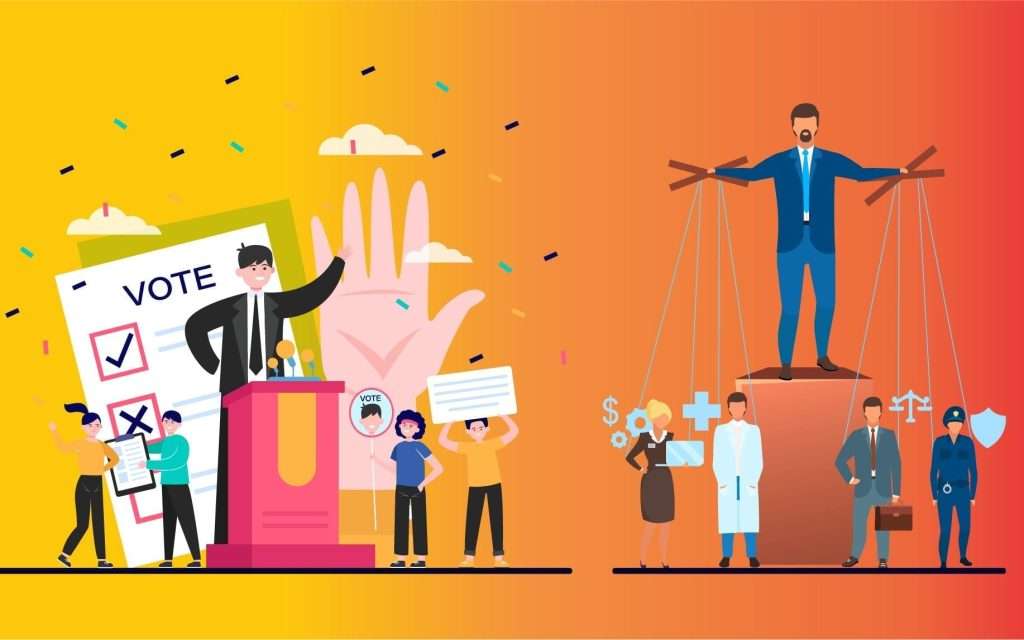
Theme: Democracy, as an ideology, has been termed as an essential pillar of progress and development internationally. In the case of India, the world’s biggest democracy, the role of democratic governance in fostering development has been a challenge to debate. This article targets to know about the complicated relationship between democracy and India’s progress by analyzing examples and records. Pros of Democracy: Democracy as a Unifying Force: India’s democratic system has been instrumental in promoting social cohesion by presenting a platform for diverse voices to be heard and represented. The ideas of equality, freedom, and recognition of personal rights embedded in democratic beliefs make a contribution to fostering a feeling of inclusiveness and shared identification. The Constitution of India, with its emphasis on secularism, has played a pivotal role in retaining social harmony with the aid of imparting equal rights and protection to all citizens, no matter their faith or ethnicity. Stability and Governance: One of the important thing advantages of democracy are its capability to make certain balance and proper governance. India’s democratic system has successfully navigated several demanding situations, inclusive of non-secular and ethnic diversity, making sure stability and social cohesion. India’s Gross Domestic Product (GDP) has proven regular growth through the years, attaining approximately $2.8 trillion in recent times. This increase may be attributed, in component, to the stability supplied via India’s democratic governance. Inclusive Development: Democracy gives a sturdy emphasis on inclusivity, ensuring that the benefits of development are shared throughout society. India’s democratic device has played an essential position in empowering marginalized groups and fostering social justice via affirmative movement guidelines and illustration in decision-making bodies. According to the World Bank, the poverty in India has substantially declined through the years, from 45% in 1994 to around 21% in 2023. This development can be attributed, in element, to democratic guidelines geared toward inclusive improvement. Accountability and Transparency: The Right to Information (RTI) Act in India allows residents to access authorities’ statistics and records, promoting transparency and maintaining public officers responsible. This regulation has been instrumental in exposing corruption scandals and empowering residents to demand better governance. According to Transparency International’s Corruption Perceptions Index, India has witnessed upgrades in its corruption ranking, shifting from 78th place to 75th place in 7 years. This high-quality trend indicates the effect of democratic measures in curtailing corruption. Democracy and Women’s Empowerment in India India’s democratic framework has furnished a platform for ladies to voice their concerns, call for the same rights, and take part in choice-making tactics. Democracy’s emphasis on equality, justice, and illustration has paved the way for widespread advancements in women’s empowerment. The implementation of constitutional provisions, together with reservations for women in local governance (Panchayati Raj establishments), has led to accelerated political participation and illustration of women in grassroots selection-making. Challenges in Democracy: While democracy has surely contributed to India’s progress, it is not without demanding situations. The democratic method may be sluggish, hindering timely choice-making. Additionally, factors such as electoral populism, political polarization, and inefficient implementation of rules can impede development. The implementation of huge-scale infrastructure tasks in India has regularly faced delays because of bureaucratic hurdles and criminal complexities. The World Bank’s Ease of Doing Business Index ranks India 63rd out of 190 nations, indicating the need for persevered reforms to improve the business surroundings and accelerate progress. Example: Although China is not a democratic country, its fast monetary boom, infrastructure improvement, and dominance in manufacturing and worldwide trade have contributed to its popularity as a more potent economic system as compared to India. One of the large demanding situations in democracies is the growing polarization of political parties and ideologies. When specific factions come to be deeply divided, it is able to cause gridlock, prevent consensus-building, and make it hard to address issues. Polarization can also make a contribution to a lack of consideration in democratic institutions and approaches, undermining the general democratic device. Corruption poses a vast chance to democracy. When public officials interact with corrupt practices, it erodes public trust, diverts resources from public welfare, and unfollows the regulation. Additionally, a loss of transparency and duty can weaken democratic institutions and avoid the powerful functioning of democratic methods. Persistent socioeconomic inequalities can stress democratic structures. When there are large disparities in wealth, training, and opportunities, certain segments of the population can also feel marginalized or excluded from the democratic manner. This can lead to social unrest, political instability, and challenges to the democratic establishments. Conclusion: The courting between democracy and India’s development is complex and multifaceted. While democracy is a crucial element in fostering balance and inclusivity. It is essential to strike a balance between democratic principles and uniform governance to make certain sustained progress. India’s adventure in the direction of progress will require ongoing reforms, institutional strengthening, and energetic citizen participation. By addressing the demanding situations and leveraging the blessings of democratic governance, India can keep its course closer to prosperity and inclusive improvement.
A Strong Analysis of Tech Layoffs – 2023

Theme: In the ever-evolving international era, tech layoffs can be a harsh fact. Companies are frequently into layoffs because of diverse motives, together with financial constraints, restructuring, or changes in marketplace demands. Understanding the motives in the back of tech layoffs, gaining knowledge of the way to stay constant, exploring powerful upskilling techniques, and familiarizing oneself with different sorts of layoffs can help navigate those difficult times. Layoff Stats: In 2023, tech layoffs have yet again cost tens of thousands of workers their jobs, the workforce layoffs have been driven by the biggest names in tech like Google, Amazon, Microsoft, Yahoo, Meta and Zoom. Startups, too, have announced cuts across all sectors, from crypto to enterprise SaaS. The reasoning behind these workforce reductions follows a common script, citing the macroeconomic environment and a need to find discipline on a tumultuous path to profitability. Still, tracking the layoffs helps us to understand the impact on innovation, which companies are facing harsh pressures and who is available to hire for the businesses lucky to be growing right now. It also, unfortunately, serves as a reminder of the human impact of layoffs and how risk profiles may be changing from here. The running total of layoffs for 2023 based on full months to date is 2,10,721 according to Layoffs.fyi. Tech layoffs conducted to date this year currently exceed the total number of tech layoffs in 2022, according to the data in the tracker. January: 84,714 employees were laid off February: 36,491 employees were laid off March: 37,109 employees were laid off April: 17,926 employees were laid off May: 14,555 employees were laid off For example: Taxfix Announced on May 30 that it has laid off 20% of its body of workers—120 employees. Meta Meta announced on May 24 that it’s far laying off approximately 6,000 employees. Overall, about 21,000 employees have lost their jobs at Meta. JioMart Reliance Retail’s online shopping platform laid off over 1,000 employees on May 22 and plans to reduce as many as 9,900 extra roles over the coming weeks. Spotify Spotify introduced on June 5 that it will cut 2% of jobs in its podcast unit, main to a body of workers. This comes only a few months after the agency announced a tremendous wave of layoffs. Amazon Amazon announced on April 26 that it’s shutting down its Halo Health department on July 31, among other divisions. The layoffs are part of the 9,000 personnel introduced in March. Including the 18,000 layoffs introduced in January, this brings the entire to 27,000 process cuts or 8% of Amazon’s corporate team of workers this 12 months. Reasons for Tech Layoffs: Economic Downturn: During periods of economic uncertainty or recession, corporations may also revel in a decline in the enterprise, main to layoffs to reduce expenses and ensure sustainability. Technological Advancements: Rapid improvements in generation can render sure activity roles or talents out of date, necessitating layoffs as corporations adapt to live competitively. Restructuring and Reorganization: When corporations undergo mergers, acquisitions, or reorganization, redundancies in roles and positions can also stand up, resulting in layoffs. Cost Reduction: Companies may additionally downsize their group of workers to lessen working fees, particularly whilst confronted with price range constraints or declining sales. Shift in Market Demand: Changes in consumer alternatives or marketplace dynamics can prompt corporations to reevaluate their techniques, mainly to layoffs in unique departments or divisions. Layoffs vs Firing: Tech layoffs contain the termination of multiple employees, regularly due to organizational reasons at the same time as firing is the single termination of an employee based totally on performance or behavioural issues. Tech layoffs are broader in scope and require a based method while firing specializes in person situations and might bring about on-the-spot termination. Understanding those variations can assist employees and task seekers navigate the employment landscape, being robust to ability challenges, and working hard as a result. It is crucial to remain adaptable, continuously enhance abilities, and hold professionalism to decrease the threat of both tech layoffs and firing. Consistency in Uncertain Times: Adaptability: In the face of layoffs, it’s far crucial to stay adaptable and open to exchange. Embrace an increased attitude and be inclined to accumulate new competencies and explore exclusive possibilities. Networking: Strengthen your professional network by attending enterprise occasions, becoming a member of online groups, and engaging with friends. Networking can offer treasured connections and the ability to process leads. Continuous Learning: Invest time in expanding your information and skill set. Identify rising traits, do relevant publications or certifications, and live updated with modern-day enterprise traits. Personal Branding: Enhance your online presence via systems like LinkedIn. Showcase your expertise, and percentage industry insights, and establish yourself as an idea leader for your domain. Emotional Resilience: Coping with layoffs can be emotionally hard. Take care of your intellectual health, search for assistance from friends and family, and don’t forget professional help if needed. Upskilling Strategies: Identify In-Demand Skills: Research the abilities which are in excessive demand inside your industry. Analyze task postings, interact with professionals, and perceive regions where upskilling can beautify your employability. Online Courses and Certifications: Explore reliable online studying systems that offer publications and certifications relevant to your preferred competencies. Platforms like Coursera, Udemy, and LinkedIn Learning offer to get entry to a huge range of courses. Professional Development Programs: Attend workshops, conferences, and seminars to live updated with enterprise tendencies and expand your network. Many groups provide education packages to assist experts upskill. Mentorship and Coaching: Seek guidance from skilled specialists for your area via mentorship packages or education periods. They can offer treasured insights and recommendations for professional progression. Collaborative Projects and Side Hustles: Engage in collaborative initiatives or begin a facet hustle to use and showcase your newly acquired skills. These reports can upload cost to your resume and demonstrate your proactive method. Types of Layoffs: Mass Layoffs: Large-scale terminations concerning a big range of personnel due to economic crises, organisation-wide restructuring, or plant closures. Department-Specific Layoffs: Layoffs targeted
Uniform Civil Code(UCC) 2023 – The ongoing strong debate

What is Uniform Civil Code (UCC)? A Uniform Civil Code (UCC) is a set of legal guidelines that would be equal for all spiritual communities in a country. It would cover subjects like marriage, divorce, inheritance, adoption, and associated problems. The idea is to replace the extraordinary personal legal guidelines primarily based on extraordinary non-secular agencies with a single set of legal guidelines that could practice by everybody. The current news on UCC: The Law Commission of India released a public observation searching for feedback on the Uniform Civil Code on 14th June 2023. The previous consultation paper on the Uniform Civil Code became issued by means of the 21st Law Commission in August 2018. The modern notification acknowledges the importance and relevance of the problem, prompting the 22nd Law Commission to revisit it. The Uniform Civil Code goals to create a standard set of legal guidelines for private matters together with marriage, divorce, adoption, inheritance, and succession. The proposed legal guidelines might be relevant to all citizens no matter their caste, gender, or religion. The Law Commission’s name for evaluations and remarks indicates a radical exam and attention of public opinion. The 5 years between the preceding and contemporary fee’s engagement highlights the importance and complexity of the Uniform Civil Code. The Uniform Civil Code intends to harmonize private legal guidelines across exceptional spiritual groups and set up a unified criminal framework. The Law Commission’s public word shows a dedication to inclusivity and equal treatment under the law for all citizens. The courtroom orders associated with the Uniform Civil Code have contributed to the renewed attention and importance given to this problem with the aid of the Law Commission. India’s Diversity: Currently, Indian non-public regulation is all fairness complex, with each religion adhering to its unique legal guidelines. Separate legal guidelines/ customs govern Hindus, Sikhs, Jains and Buddhists, Muslims, Christians, and followers of different religions. Moreover, there is diversity even within groups. All Hindus of us of aren’t ruled by using one law, nor are all Muslims or all Christians. For instance, in the Northeast, there are more than 200 tribes with numerous customary legal guidelines. The Constitution itself protects nearby customs in Nagaland. Similar protections are offered in Meghalaya and Mizoram. The exception to this rule is the kingdom of Goa, in which all religions have a commonplace regulation concerning marriages, divorces, and adoption. Constitutional position: Article 44 of the Constitution lays down that the nation shall endeavour to stable a UCC for citizens throughout the territory of India. Article 44 is some of the Directive Principles of State Policy. Directive Principles aren’t enforceable via the courtroom but are meant to inform and guide governance. Previous efforts of UCC: Shah Bano judgement: In 1986, the Supreme Court’s Shah Bano judgment for renovation was considered a primary step in the direction of UCC. However, it turned into nullification with the aid of the Parliament by passing an amendment to keep the repute quo. Incremental changes over the years: Incremental change has passed off over a long time. Hindu succession became reformed with the aid of Parliament in 2005, and Christian divorce rights have also been reformed in 2001. The courts have step by step affirmed women’s rights of protection, adoption, and so forth. In various judgments, strengthening reform in minority groups. In 2018, the 21st Law Commission underlined that the Uniform Civil Code is neither important nor ideal at this stage. It argued for reform of own family laws of each religion thru amendments and codification of sure elements to cause them to gender-simply. It in addition stated that cultural diversity can not be compromised to the quantity that our urge for uniformity itself turns into a motive for a risk to the territorial integrity of the kingdom. Need for UCC: 1. To promote national unity Historically, one of the factors that have stored India back from advancing to nationhood has been the life of personal laws primarily based on religion. These laws maintain the nation divided into watertight cubicles in many components of existence. A uniform regulation made applicable to all would promote national harmony. 2. Different personal laws are put to subversive use There were times of Hindus converted to Islam, as bigamy is a part of Muslim private legal guidelines in the country. 3. To promote gender justice A uniform civil code is needed for gender justice. The rights of ladies are generally limited below non-secular regulations, be they Hindu or Muslim. 4. Not in the domain of religious activities Matters together with inheritance, marriage, divorce etc. Do no longer need to do something with spiritual sports. Hence, any regulation on these elements might no longer amount to the infringement on religious freedom extended via Article 25. 5. The vision of constitution-makers The Constitution makers had an imaginative and prescient to enact UCC in future to have the same set of civil legal guidelines governing all irrespective of religion. Enactment of UCC is needed to fulfil this dream. Arguments against UCC: 1. Diversity cannot be compromised for uniformity The imposition of UCC could lead to overlooking the variety of Indian cultures, customs, ethnicity, languages, religious ideologies and so on. From north to south and from east to west, each state in India has a one-of-a-kind lifestyle and a specific outlook toward existence. 2. Violation of fundamental rights The ideas of marriage, talaq and polygamy are interwoven with the religious and cultural rights of Muslims. State intervention will be the violation of essential rights (Articles 25, 26, 29). 3. Constitution recognises the customary laws and procedures prevailing in NE states In the North Eastern States, the constitution thru the VI schedule recognizes the normal laws and tactics prevailing in their society. Hence, there can be sensible problems in the formulation in addition to the implementation of UCC. 4. Detrimental to communal harmony of India Perception of UCC as an encroachment on spiritual freedom is gaining momentum. In this context, many agree that UCC may be detrimental
Evaluating the Quota System in India 2023: A Controversial Tool for Social Equality
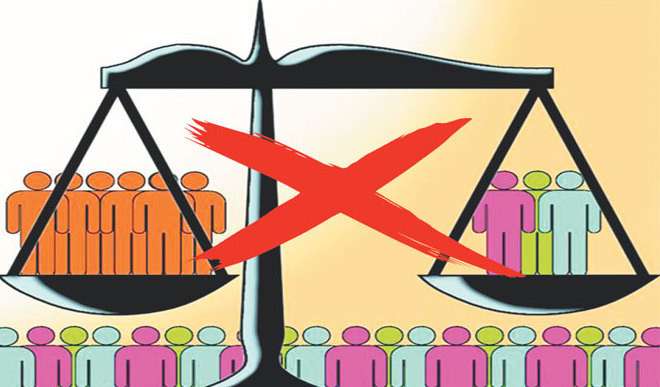
Theme: India, as a diverse nation with a complicated society, has long troubles of social and economic inequality. In a try to deal with historic injustices and promote inclusivity, the Indian authorities introduced a quota system, additionally referred to as affirmative motion or reservation, in diverse spheres of public life. However, this coverage has sparked excessive debate and raised questions on its efficacy, equity, and long-time period effect on society. In this article, we will be able to discover the pros and cons of the quota system in India, supported by means of records and actual-world examples. Historical Context and Objectives: The origins of the quota system in India may be traced back to the united states charter, which aimed to eliminate discrimination and uplift marginalized sections of society. The system normally specializes in reservations in training, authorities jobs, and legislative bodies, reaping benefits traditionally deprived agencies, together with Scheduled Castes (SC), Scheduled Tribes (ST), and Other Backward Classes (OBC). Proponents argue that those reservations are essential to provide identical opportunities and bridge the socio-monetary divide that has affected the kingdom for hundreds of years. Positive Impact and Empowerment: Supporters of the quota device highlight several advantageous consequences. Firstly, it has given possibilities to historically marginalized communities that were denied get right of entry to education and employment because of social discrimination. Data shows that the illustration of SC, ST, and OBC groups in better training institutions and public services has substantially extended over the years. Understanding the reservation system in India: Reservation in Education: Seats in higher education institutions are reserved for SC, ST, and OBC college students (15%, 7.5%, and 27% respectively). Almost half of the undergraduate students come from those reserved classes. IITs have visible a sizable growth within the range of SC, ST, and OBC college students due to reservations. Reservation in Government Jobs: Reserved quotas make certain that a sure percentage of jobs are reserved for SC, ST, and OBC candidates in the public zone. About 15% of presidency jobs are reserved for SC applicants and 7.5% for ST candidates. In primary authorities’ jobs, the illustration of SC, ST, and OBC personnel has stepped forward through the years. Socio-financial signs: Despite reservations, there are nevertheless disparities in training and earnings. The literacy fee is decreased among SC and ST populations compared to the overall populace. SC and ST groups have decreased average month-to-month in line with capita spending compared to different companies. Unemployment rates are higher for SC and ST individuals in comparison to the general populace. These data spotlight the impact of reservation regulations in schooling and authorities’ jobs, as well as the present socio-monetary disparities that persist despite those measures. Implementation Issues: While the quota system in India has executed some high-quality results, it isn’t always without its demanding situations. Critics argue that the system has regularly been implemented without thinking about elements along with economic repute and regional variations, that could perpetuate inequalities inside the reserved categories themselves. This has brought about instances where individuals from privileged backgrounds within those classes benefit and get entry to reserved seats, similarly marginalizing those absolutely in want. Additionally, the criteria for determining backwardness and the percentage of reserved seats have grown to be topics of political debate. Creamy Layer Exclusion: The concept of the “creamy layer” refers back to the distinctly prosperous and socially superior individuals inside the reserved classes who do not face the same stage of social and monetary downside. The creamy layer exclusion principle pursuits to prevent individuals from privileged backgrounds within reserved classes from making the most of reservations, ensuring that the advantages attain to those who are really deprived. However, imposing the creamy layer exclusion efficiently has been a mission, as determining the standards and correctly figuring out people within the creamy layer have proven complicated and subjective. Inadequate Infrastructure and Resources: While reservations offer to get the right of entry to educational institutions and jobs, the shortage of good enough infrastructure and sources in marginalized communities can avert their potential to compete on an identical footing. Insufficient colleges, inadequate coaching personnel, and confined get admission to satisfactory healthcare and different important services make a contribution to a gambling subject, limiting the overall effectiveness of reservations in attaining social equality. Reservation Backlog and Inefficiencies: The reservation system regularly results in a backlog of vacant positions, especially in educational institutions and authorities jobs, due to the prescribed quota system. This backlog creates administrative demanding situations and delays in filling positions, that may impact productivity and prevent green governance. In some cases, those vacancies stay unfilled, main to a loss of capacity possibilities for each reserved and non-reserved candidate. Consequences and Backlash: One situation related to the quota device is the ability for negative accidental results. Meritorious individuals from non-reserved classes can also feel disadvantaged and understand reservations as a shape of reverse discrimination. This perception has given an upward push to social tensions, with a few arguing that the quota system perpetuates a tradition of entitlement in preference to fostering meritocracy. Furthermore, reservations can inadvertently support societal stereotypes and stigmatization, hindering efforts in the direction of genuine equality and social integration. Long-Term Solutions and Alternatives: To deal with the restrictions of the quota system, there had been calls for reforms and opportunity techniques. Some endorse implementing a greater nuanced machine that considers monetary backwardness along social elements. Additionally, funding in fine primary education, talent development applications, and healthcare centres can help bridge the gap between privileged and marginalized communities, ensuring identical opportunities for all. Such complete strategies ought to foster an inclusive society without compromising the principles of meritocracy. Conclusion: The quota system in India stays a contentious problem with strong arguments on both aspects. While it has undeniably supplied possibilities to historically marginalized groups and fostered social empowerment, critics argue that it needs cautious evaluation and reform to deal with implementation-demanding situations and accidental consequences.
The Ongoing dispute in Manipur: A breaking scenario in 2023
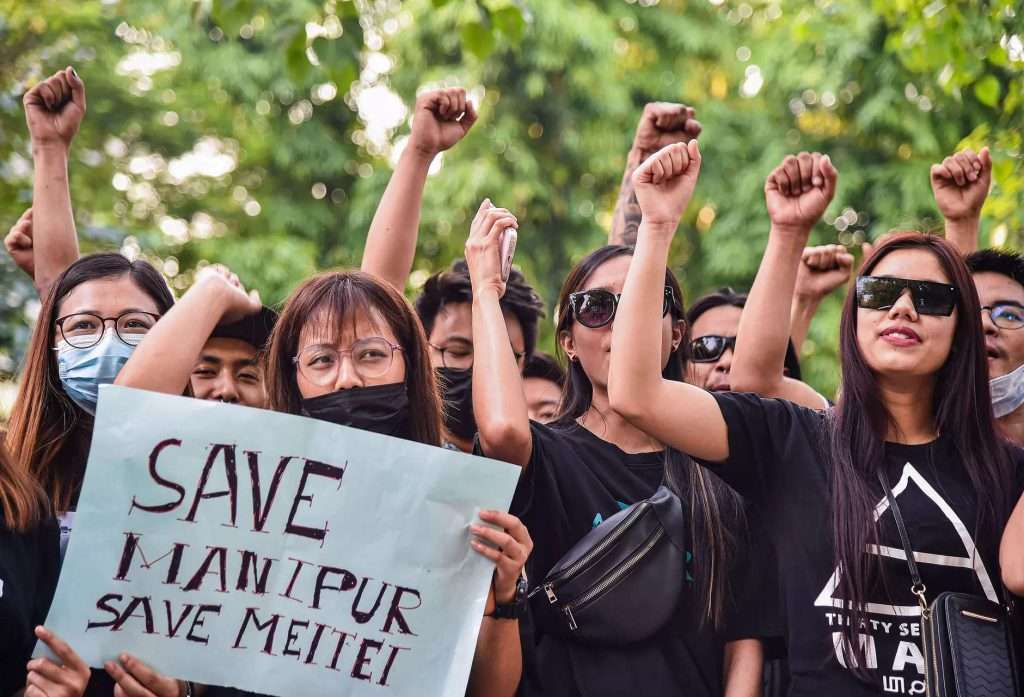
Theme: The ongoing dispute in Manipur is a result of ethnic tensions between the Meitei and Kuki-Hmar-Zomi people in Manipur. The Meitei people, who are bulk in the Imphal Valley, had been annoying a Scheduled Tribe status below the Indian Constitution, which might deliver them privileges corresponding to the tribal groups. This has led to protests by the tribal groups who are in opposition to the Meitei call. This article will lets us know the principal causes and outcomes of the inner dispute in Manipur. What are the main causes of the ongoing conflict in Manipur? The ongoing dispute in Manipur is a complex problem that has been brewing for decades. Here are a number of the principal reasons for the conflict, consistent with the search results: Long-standing inter-network war: The violence in Manipur is by and large because of inner disturbance induced by lengthy unresolved inter-network battles. The nation is domestic to an ethnically numerous group of Sino-Tibetan groups, every with its specific language, way of life, and religion. The Meitei, Kuki, Naga, and Zo tribes are a number of the fundamental groups in Manipur. The demonstrations escalated into violent confrontations between Naga and Kuki organizations and the Meitei, inflicting Indian protection forces to installation The massive influx of illegal immigrants: The Manipuri (Meitei) Association, Navi Mumbai (MMANM) has expressed deep concern over the ongoing war in Manipur which “threatens the peace, protection and socio-cultural material of the country. The root purpose of this warfare lies within the massive influx of both armed and unarmed illegal immigrants from the bordering USA that led to the destabilization of Manipur’s demographic profile, assets, and protected regions/ land. The imbalance in land ownership and shopping rights, at the side of the trafficking of medication and arms via porous worldwide boundaries, poses a considerable threat to the state’s and finally kingdom’s security. Marginalization of communities: Tribal businesses are protesting the prospect of Manipur’s majority Meitei network being identified as a “Scheduled Tribe”. Constitutionally identified, this authentic designation offers positive protections to tribes and groups. “It is an affirmative movement to ensure marginalized groups are represented and gives them reservations and quotas in instructional institutions and authorities jobs,” said Arunabh Saikia, a journalist who has protected the location. The Meiteis declare they’re marginalized compared to the alternative mainstream communities. Insurgencies: Manipur has had a long record of civil conflict because of cutting-edge India’s introduction. The kingdom has grappled with insurgencies, violence, and marginalization for decades. The violence has traditionally been ethnic, and even as there may be a few overlaps with faith, it has usually remained an ethnic conflict with some instances of inter-tribe violence as well. What is the effect of the war on the people of Manipur? The ongoing warfare in Manipur has had a huge effect on the people of the country. Here are some of the approaches in which warfare has affected humans, consistent with the hunt consequences: 1. Loss of existence and displacement: The violence in Manipur has resulted in the loss of many lives, with a minimum of 75 deaths stated thus far. The burning of houses, non-secular websites, and other houses have also been stated. More than 35,000 humans were displaced and are presently residing in treatment camps. The scenario remains hostile, and the huge variety of displaced human beings may additionally preserve and rise because the prevention keeps. 2. Fear and lack of confidence: The ongoing battle has created a sense of fear and absence of confidence in most of the people of Manipur. The violence has been tremendous, and those are afraid to go away from their houses or flow about their day-by-day lives. The state of affairs is especially annoying in areas wherein there may be high attention to special ethnic companies. 3. Economic effect: The war has moreover had an enormous economic impact on the human beings of Manipur. The burning of houses and agencies has left many humans without a supply of income. The displacement of human beings has additionally disrupted monetary interest in the united states. What is the position of civil society businesses in addressing the conflict in Manipur? What is the position of civil society businesses in addressing the conflict in Manipur? Civil society organizations can play a vital role in addressing the continuing conflict in Manipur. Here are a number of the roles that civil society corporations can play, consistent with the quest results: 1. Promoting conflict resolution: Civil society corporations can sell struggle decisions by bringing different groups collectively and fostering expertise among them. Joint protests via Meitei, Kuki, and Muslim civil society organizations in Manipur have adverse decisions that could strengthen the struggle. 2. Representing the civil society of Manipur: Civil society businesses such as AMSU, AMUCO, and UCM claim to symbolize the civil society of Manipur. These organizations can play a position in advocating for the wishes and worries of the people of Manipur and selling peace and stability inside the kingdom. 3. Showing extra activism: Human rights and civil society companies were active inside the region and featured proved extra activism in achieving one-of-a-kind communities. These agencies can play a role in promoting communication and understanding between specific communities and advocating for peaceful solutions to warfare. 4. Negotiating throughout ethnic divides: Civil society groups can negotiate across ethnic divides that otherwise harden and perpetuate warfare. These companies can play a role in bringing special communities together and finding commonplace ground for a non-violent resolution of the war. 5. Raising attention about the root reasons for the warfare: Civil society organizations can raise consciousness about the basic causes of the battle, along with the huge inflow of illegal immigrants from the bordering country. By elevating attention to those problems, civil society groups can help to address the root causes of the battle and save you similarly destabilization of Manipur’s demographic profile, assets, and guarded regions/ land. Conclusion: In the end, the continuing dispute in Manipur is a complicated difficulty that has been
ChatGPT vs Google Bard
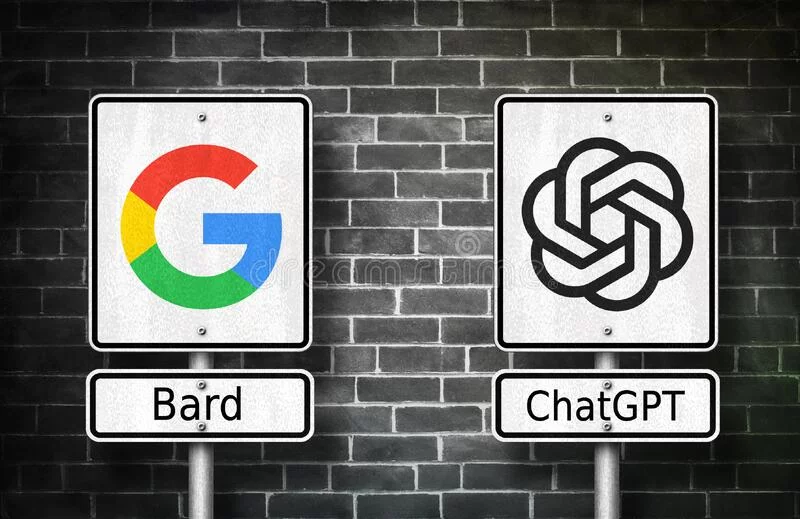
ChatGPT vs Google BARD: A Battle of Language Models Theme: In this article, we will look into the similarities, differences, and unique capabilities of ChatGPT and Google BARD, exploring their abilities and ability implications for numerous programs. What is ChatGPT? Chat GPT, advanced by means of Open AI, is an outstanding language model built at 3.5 architecture. It has been trained on an intensive corpus of textual content from the internet and possesses a top-notch potential to generate coherent and contextually applicable responses. Chat GPT can provide facts, interact in conversations, or even show off an experience of humor. The version is designed to be incredibly interactive, permitting users to have dynamic and attractive exchanges. What is Google BARD? On the opposite hand, Google BARD (Bidirectional Encoder Representations from Transformers) is every other modern language model developed by way of Google. BARD, built upon the Transformer structure, boasts a completely unique set of functions that units it apart from ChatGPT. One super function of BARD is its capacity to understand and generate text in more than one language, making it a flexible tool for international verbal exchange. Additionally, BARD is educated on a considerable amount of information, permitting it to the manner and recognize facts speedy and correctly. ChatGPT vs Google Bard: When evaluating the two fashions, one of the primary variations lies in their training methods. ChatGPT is based on unsupervised getting-to-know, soaking up large quantities of text data and predicting what comes next in a given sequence. This technique allows ChatGPT to generate coherent responses primarily based on the context it gets. In contrast, Google BARD is skilled the use of an aggregate of supervised and unsupervised mastering strategies. Supervised studying includes schooling the version on labelled facts, which allows enhancing its accuracy and overall performance on precise responsibilities. 1. Accuracy When it comes to accuracy, each ChatGPT and Google BARD have their strengths and weaknesses. ChatGPT is educated to be greater versatile, making it better at textual capabilities like writing articles or emails or developing content advertising ideas. However, it may be a little vague and often offers universal answers (even when you ask it now not to). On the other hand, Google BARD is predicted to offer extra correct information, thanks to its ability to search via the net after output with its “Google it” function. 2. Intelligence In terms of intelligence, ChatGPT has the top hand. ChatGPT 4 reveals a more humanlike and shrewd approach, making it a notable tool for creating written content. Google BARD, alternatively, is designed to enhance research and knowledge across schooling, enterprise, and other fields. While both AI language fashions have room for development, ChatGPT four exhibits a more humanlike and shrewd approach. 3.Coding When it involves coding, both ChatGPT and Google BARD have their strengths and weaknesses. ChatGPT is crafted with OpenAI’s modern-day Generative Pre-trained Transformers (GPT) fashions, making it a fantastic tool for a huge variety of programs. Google BARD, alternatively, uses Google’s LaMDA language version, which is designed to provide a human-like verbal exchange revel to its customers. 4. Information Analysis In terms of records analysis, Google BARD has the higher hand. Google BARD has the capability to pull statistics from the stay internet, making it greater effective than ChatGPT in terms of facts analysis. ChatGPT, then again, has constantly been confined by using its lack of ability to access the internet. Despite upgrades inside the GPT-four version, the AI chatbot relies upon a dataset that excludes occasions post-September 2021. 5. User Experience When it comes to personally enjoy, Google BARD gives a higher enjoyment. Google BARD is extra comforting, but at the same time as ChatGPT’s interface feels sort of cold and scary – such as if you’re interacting with a top-notch smart robotic (that you are). Furthermore, both models may additionally every so often produce outputs that appear plausible but are factually incorrect or deceptive. This highlights the importance of essential wondering and fact-checking while relying on the statistics generated by way of these models. It is crucial to apply them as gear to assist human intelligence as opposed to entirely counting on them as authoritative assets of records. Key features of ChatGPT: Developed by means of OpenAI Uses Generative Pre-educated Transformers (GPT) fashions Can be used to create written content material simply. Trained to be flexible, making it a splendid tool for an extensive range of programs. Relies on restrained knowledge that’s best modern as much as the 12 months of 2021. Key features of Google Bard: Powered by means of the Language Model for Dialogue Application (LaMDA). Designed to offer customers a human-like verbal exchange. Can offer responses based on real-time, modern-day studies pulled from the net. Has the potential to take out statistics from the web. Designed to enhance studies and information across education, commercial enterprise, and other fields. Able to use up-to-date statistics for its responses. Has a main focus on conversational questions and solutions. Uses Google’s Pathways Language Model (PaLM 2). What are the restrictions of ChatGPT and Google Bard: Here are the restrictions of ChatGPT and Google Bard in phrases of language assist: Chat GPT Chat GPT relies on restricted expertise that’s most effective and cutting-edge up to the year 2021. Chat GPT is primarily based on records that were often gathered up until 2021, so it does not have to get admission to the total variety of fabric on the internet. Chat GPT may additionally produce out-of-date responses. Google Bard Google Bard’s language aid is limited to English most effective. Google Bard’s responses can be biased or include mistakes, as it is still in improvement. Google Bard’s LaMDA model might not be able to understand certain dialects or accents. Conclusion: In the end, Chat GPT and Google BARD are excellent language fashions that have considerably advanced the sphere of language processing. While Chat GPT offers public accessibility and interactive conversational abilities, Google BARD stands proud of its multilingual competencies. Both models have their strengths and obstacles,
